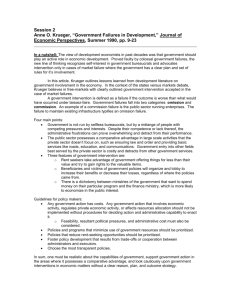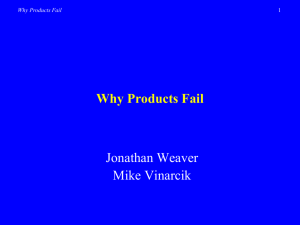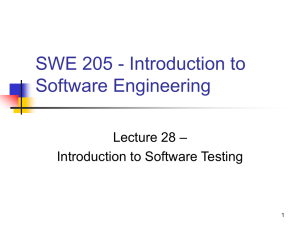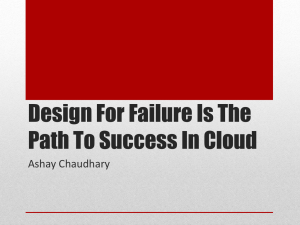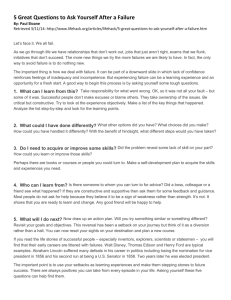Click here to get the file - ENMU ITS Web Media Server
advertisement
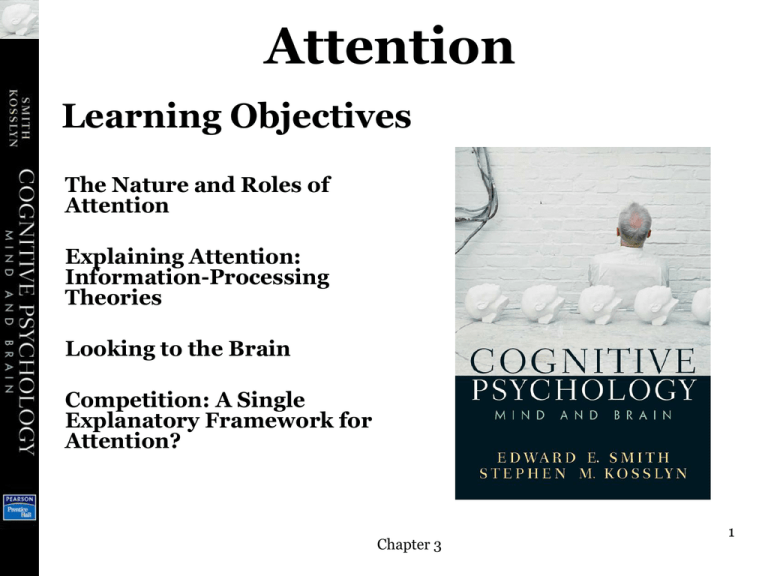
Attention Learning Objectives The Nature and Roles of Attention Explaining Attention: Information-Processing Theories Looking to the Brain Competition: A Single Explanatory Framework for Attention? Chapter 3 1 Attention In the context of human information processing, attention is the process that, at a given moment, enhances some information and inhibits other information. The enhancement enables us to select some information for further processing, and the inhibition enables us to set some information aside. Chapter 3 2 The Nature and Roles of Attention Failures of Selection Successes of Selection Chapter 3 3 Failures of Selection Failures of Selection in Space Failures of Selection in Time Sources of Limitation Problems in Interpretation When the Brain Fails Chapter 3 4 Failures of Selection When we fail to attend to information, what kind of information do we miss? One sort of failure occurs when there is a lot of information simultaneously present in front of you, as at a party, and you are simply not capable of noticing all of it at once. These failures are referred to as failures of selection in space. Failure can also occur with information that unfolds in time. Chapter 3 5 Failures of Selection in Space Failures of selection in space can be of surprising magnitude. Perhaps the most dramatic of these was a demonstration by Simons and Levin (1998) in which an experimenter stopped pedestrians on a college campus to ask for directions. This failure to detect changes in the physical aspects of a scene has been referred to as change blindness. This phenomenon often goes to the movies: errors in continuity, such as the switch from the breakfast croissant to the pancake in Pretty Woman, go unnoticed by many in the audience. Chapter 3 6 Failures of Selection in Space Failures of selection in space can be of surprising magnitude. Perhaps the most dramatic of these was a demonstration by Simons and Levin (1998) in which an experimenter stopped pedestrians on a college campus to ask for directions. This failure to detect changes in the physical aspects of a scene has been referred to as change blindness. This phenomenon often goes to the movies: errors in continuity, such as the switch from the breakfast croissant to the pancake in Pretty Woman, go unnoticed by many in the audience. Chapter 3 7 Failures of Selection in Space Chapter 3 8 Failures of Selection in Space Concentration on one source of input to the exclusion of any other is known as focused attention; in cases of divided attention, in which more than one source is attended, the information selected is imperfect. Chapter 3 9 Failures of Selection in Space Chapter 3 10 Failures of Selection in Time When new information (even if only a small amount) arrives in a rapid stream, spending time processing it will cause you to miss some other incoming information, resulting in what are called failures of selection in time. These failures to attend to information in space or in time are a byproduct of a system that prevents us from becoming overloaded with irrelevant information—that is, of a system of selective attention. Chapter 3 11 Failures of Selection in Time Chapter 3 12 Sources of Limitation As the term suggests, attentional blink is a short period during which incoming information is not registered, similar in effect to the physical blanking out of visual information during the blink of an eye. Some models propose the notion of a bottleneck, a restriction on the amount of information that can be processed at once; because of the bottleneck, certain critical mental operations have to be carried out sequentially. Divided-attention studies demonstrate that performance is hampered when you have to attend to two separate sources of visual information or two separate visual events. In all these cases, the decrement in performance is referred to as dual-task interference. Chapter 3 13 Problems in Interpretation Although cognitive psychologists have spent a great deal of time and effort examining divided attention and the costs associated with dual tasks, many questions remain. A second problem that has muddied the dual-task waters is that it is not possible to guarantee that when you do two things at the same time, you’re doing them in exactly the same way as you would if you were performing each task singly. In the late 1970s Shiffrin & Schneider (1977) used just this terminology and described processing as being either automatic or controlled Just as our example of driving experience suggests, they found that people use automatic processing on easy or very familiar tasks but are forced to use controlled processing for difficult or new tasks. Chapter 3 14 When the Brain Fails Normal pattern of failures, however, is massively exaggerated in those who suffer from hemispatial neglect, a deficit of attention in which one entire half of a visual scene is simply ignored. The cause of hemispatial neglect is often a stroke that has interrupted the flow of blood to the right parietal lobe, a region of the brain that is thought to be critical inattention and selection. Chapter 3 15 When the Brain Fails When these patients are asked to copy or even draw from memory a clock or a daisy, they do not attend to (that is, they fail to select) information on the side of space opposite the lesion and so do not incorporate this information in their pictures. Chapter 3 16 When the Brain Fails Chapter 3 17 Successes of Selection Endogenous and Exogenous Effects in Space Components of Attention Cross-Modal Links Object-Based Attention Chapter 3 18 Endogenous and Exogenous Effects in Space When you came into the room, you searched very broadly and rapidly for all green things in the array of colors that surrounded you and then, within this subset of green things, specifically for your friend’s dress. This sort of attentional process, which has a voluntary aspect, is top down; it originates from within (from your own knowledge, in this case) and hence is called endogenous attention. Chapter 3 19 Endogenous and Exogenous Effects in Space But this form of goal-driven or top-down attention, can be overridden: salient and powerful stimuli can capture attention and direct you away from the task at hand. Attention thus captured is described as exogenous attention, because it is driven in a bottom-up fashion by stimuli generated outside oneself. Like the sound of the breaking glass, strong color can provide an exogenous cue, and can be very useful: little children on field trips and prisoners in work-release programs wear brightly colored shirts for the same reason. Chapter 3 20 Endogenous Cueing Task Chapter 3 21 Components of Attention What happens when patients with hemispatial neglect perform this attentional cueing task? Patients with lesions to the right parietal lobe, many of whom also suffered hemispatial neglect, detected the valid targets normally on the nonneglected right side and almost normally on the neglected left side. The findings from patients with brain damage led Posner and colleagues to construct a model for attention that involves three separate mental operations: disengaging of attention from the current location; moving attention to a new location; and engaging attention in a new location to facilitate processing in that location. Chapter 3 22 Components of Attention Interestingly, Posner and colleagues found other patient groups who appeared to be impaired in either the “move” or “engage” operations posited by their attention model. Patients with damage to the midbrain and suffering from a disorder called progressive supranuclear palsy seemed to have no difficulty with “disengage” or “engage” operations. Rather, they were slow in responding to cued targets in the direction in which they had difficulty orienting, suggesting a problem in moving attention to the cued location. Chapter 3 23 Cross-Modal Links Although many studies have focused on attentional effects in vision, there is also evidence that facilitatory and inhibitory effects can be found within and across different sensory modalities. In one experimental design, demonstrated cross-modal priming under both exogenous and endogenous conditions, participants held tactile stimulators that could vibrate at either the thumb or index finger in each hand. Four light-emitting diodes were placed in corresponding locations in space. When participants were asked to report the location of the tactile stimulus, the presence of a noninformative visual flash on the same side of space speeded responses. Chapter 3 24 Cross-Modal Links The reverse condition was also true: a random tactile stimulus primed responses to visual targets on the same side. When participants crossed their hands, the priming was found to be aligned with external space (that is, the left hand crossed to the right side of the body primed detection of a visual stimulus on the right). These effects have also been found between audition and touch, and between audition and vision. Chapter 3 25 Object-Based Attention In life, we are surrounded by objects, animate and inanimate, of all sorts, and attention is directed toward them as well as to locations in space and positions in temporal sequence. Recent studies of object-based attention show that when attention is directed toward an object, all the parts of that object are simultaneously selected for processing. An immediate example: you think of your friend in green as a single object (and no doubt, because she’s a friend, as greater than the sum of her parts). As you focus on her, you would be more likely to notice the watch on her wrist, because it is a part of her, than to notice the watch worn by the person standing next to her, even if that person is standing just as close to you as she is—that watch is a part of a different object. Chapter 3 26 Object-Based Attention Chapter 3 27 Object-Based Attention Chapter 3 28 Object-Based Attention Chapter 3 29 Object-Based Attention Chapter 3 30 Explaining Attention: Information-Processing Theories Early versus Late Attentional Selection Spotlight Theory Feature Integration Theory and Guided Search Chapter 3 31 Early versus Late Attentional Selection The British psychologist Donald Broadbent (1926–1993) favored the view that selection is made at an early stage of processing. He proposed a model of the attentional system as containing a limited-capacity channel through which only a certain amount of information could pass. The many sensory inputs capable of entering later phases of processing, he believed, had to be screened to let only the most important information through. Chapter 3 32 Spotlight Theory Consistent with the idea that spatial locations can be enhanced when they fall in and around the spotlight, participants who correctly named letters appearing at multiple locations in the visual field were more likely to succeed at an orientation discrimination task when the forms to be discriminated appeared near the letters. However, a number of experiments have shown that attention can be directed to a single object, even if superimposed on another object, demolishing the idea that a “spotlight” of attention highlights information in a particular spatial region. Chapter 3 33 Spotlight Theory If that were true, all objects would be selected together but we know that one object can be preferentially selected. Another difficulty is the assumption of the spotlight model that the beam of attention sweeps through space. If that’s what happens, one would expect that if an obstacle intervened in the course of the sweep, attention would be captured or hampered by this obstacle. Chapter 3 34 Feature Integration Theory and Guided Search In Disjunctive (or feature) search trials the target differs from the other characters or symbols—the distractors—by a single feature, such as shape (circle among squares). Distractor is a nonrelevant stimulus that is supposed to be ignored. The target is defined by a conjunction of features—here, color (blue versus white) and shape (circle versus square) in Conjunctive search trials. Chapter 3 35 Feature Integration Theory and Guided Search Chapter 3 36 Feature Integration Theory and Guided Search Chapter 3 37 Looking to the Brain Electrophysiology and Human Attention Functional Neuroimaging and Transcranial Magnetic Stimulation Chapter 3 38 Electrophysiology and Human Attention In the late 1960s, technology was developed that allowed researchers to measure with considerable precision the variation in electrical activity generated by the brain. The major result from some of these ERP studies was that directing attention toward a stimulus results in an increase in the amplitude of the waveform as early as 70 to 90 milliseconds after the onset of the stimulus. A similar increase in the sensory ERP occurs when attention is exogenously drawn to a location if the target appears within 300 milliseconds of the exogenous cue. Chapter 3 39 Functional Neuroimaging and Transcranial Magnetic Stimulation Data from ERP studies have been very useful in demonstrating that some attentional modulation occurs during the first phases of cortical processing, and in showing similarities across endogenous and exogenous cueing and across visual, auditory, and tactile domains. These data have been able to do this because of the temporal precision of the ERP technique, allowing measurement of changes in brain waves over time even down to a matter of milliseconds. But ERP methods are not that good at indicating exactly which region of the brain is responsible for generating the brain waves. Chapter 3 40 Functional Neuroimaging and Transcranial Magnetic Stimulation Chapter 3 41 Competition: A Single Explanatory Framework for Attention? Conceptualizations of selective attention have undergone many transformations over the history of attention studies. Early theories drew analogies between attention and a filtering mechanism or bottleneck that operated in accordance with a set of early perceptual or later semantic criteria. Later theories recast attention as the selective distribution of a limited amount of cognitive resources. Now attention was seen not as a discrete gateway or bottleneck but as a modulatory influence that could increase or decrease the efficiency with which demanding processing is performed. Click here for A CLOSER LOOK Chapter 3 42 Think Critically Does studying in a noisy environment such as a coffee shop help you focus or does it distract you? Do the level of noise and the difficulty of the subject matter or its type (verbal, pictorial) affect the suitability of a study location? How? Chapter 3 43 Think Critically What would it be like if you were equally aware of all the visual and auditory details of your environment at once? Would this be an advantage or a disadvantage? Chapter 3 44 Think Critically From knowledge of the different theories of attention, what advice would you give to advertising agencies for creating advertisements that are likely to be noticed and read? What advice would you give to Web masters who want to control the distractibility of Web advertisements on their pages? Chapter 3 45 Think Critically How does biased competition differ from the other theories of attention? How can the idea that the information we are aware of is essentially the “winner” of competing information be used to inform laws about using cell phones while driving? Chapter 3 46 The End. Chapter 3 47 A CLOSER LOOK Competition and Selection Click here to THINK CRITICALLY Chapter 3 48 Introduction The investigators used fMRI to test ideas about competition and attentional selection. The idea being explored is that the visual system is limited in its capacity to process multiple stimuli at any given time. The hypothesis: in order for objects to be selected, competition must occur between available objects to yield a “winner.” The suppression of the eventual winner by the “losing” stimuli would give rise to a reduction in the signal measured by fMRI. In addition, the investigators argue that this suppression can be overcome even when multiple objects are present: if attention is directed to one of the objects specifically, the response would be enhanced and lead to stronger fMRI signals. Click here to THINK CRITICALLY Chapter 3 49 Method Eight participants viewed images appearing on a screen while lying in the fMRI scanner. Two conditions were used in the first experiment. In the sequential condition, four complex images were shown in random locations on the screen but only one object was ever present at a single time. In contrast, in the simultaneous condition, the same four complex images were present, but in this condition all four were present at the same time. Because competition (and suppression) can take place when all four are simultaneously present, the expectation was that the fMRI signal from visual cortex in the simultaneous condition would be lower than the sum of the four fMRI signals in the sequential condition. The second experiment was the same as the first but now, in some sets of trials, participants were instructed to attend to a particular location in which one stimulus was presented and to count the occurrences of a particular target stimulus at that location. Click here to THINK CRITICALLY Chapter 3 50 Results Markedly weaker signals were observed in many visual areas of the brain in the simultaneous than in the sequential condition, supporting the idea that the stimuli presented together competed with one another and, in so doing, led to the suppression of some of them. When stimuli are presented one at a time, each can activate the brain fully and so the sequential condition leads to stronger fMRI signals. It is interesting and important that in the second experiment, when the participants attended to the location of one of the stimuli, there was an increase in the strength of the fMRI signal, and this signal was even larger than in the sequential condition in some visual areas of the brain. Click here to THINK CRITICALLY Chapter 3 51 Discussion The hypothesis was that competition among multiple stimuli would lead to suppression and that this would be reflected by a reduction in the fMRI signal. This was indeed the case, and this finding provides support for the idea that attention is a dynamic process in which stimuli compete for selection. Competition, then, may be the means by which unwanted stimuli are filtered out (they are suppressed and have little or no activation). The second experiment shows that one can enhance some stimuli by attending to them even if there are many stimuli present; this finding shows that along with suppression, enhancement occurs when one selects a subset of items for further processing. Click here to THINK CRITICALLY Chapter 3 52

